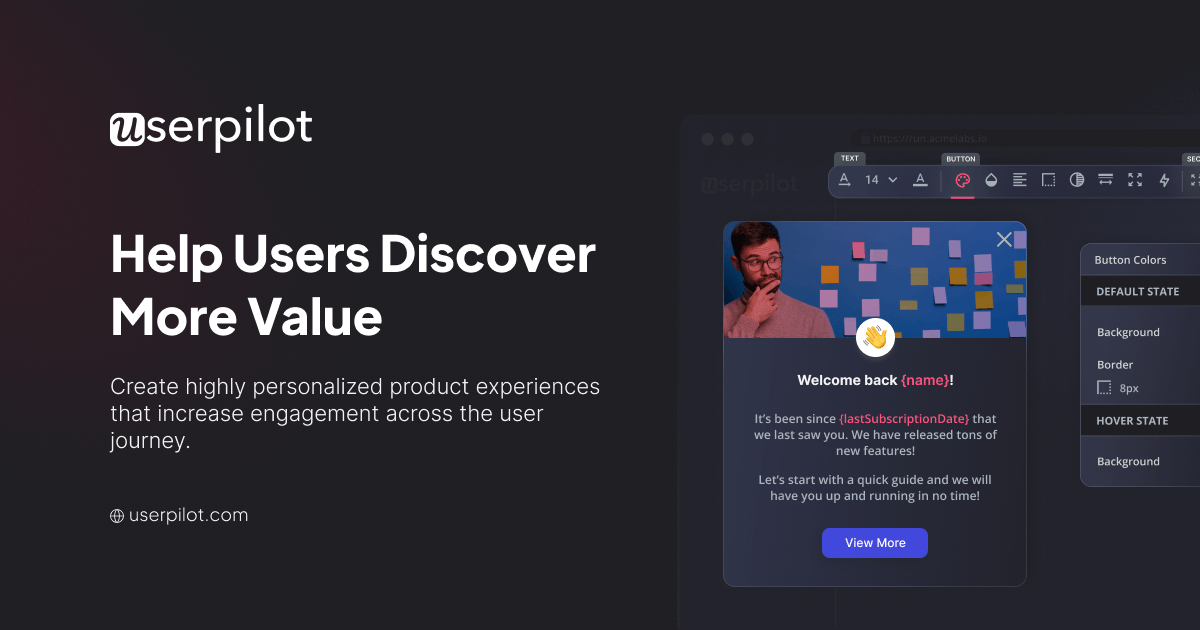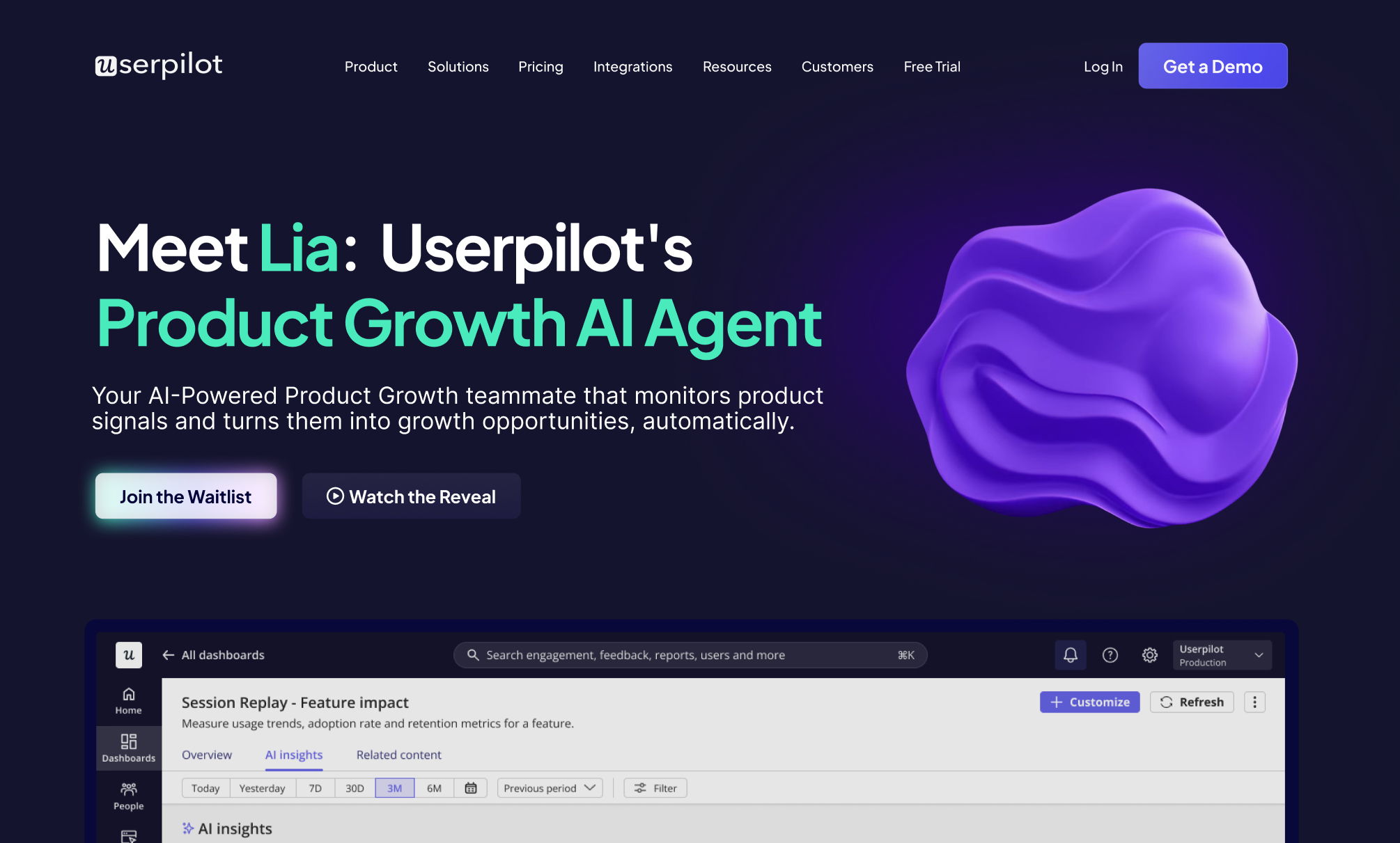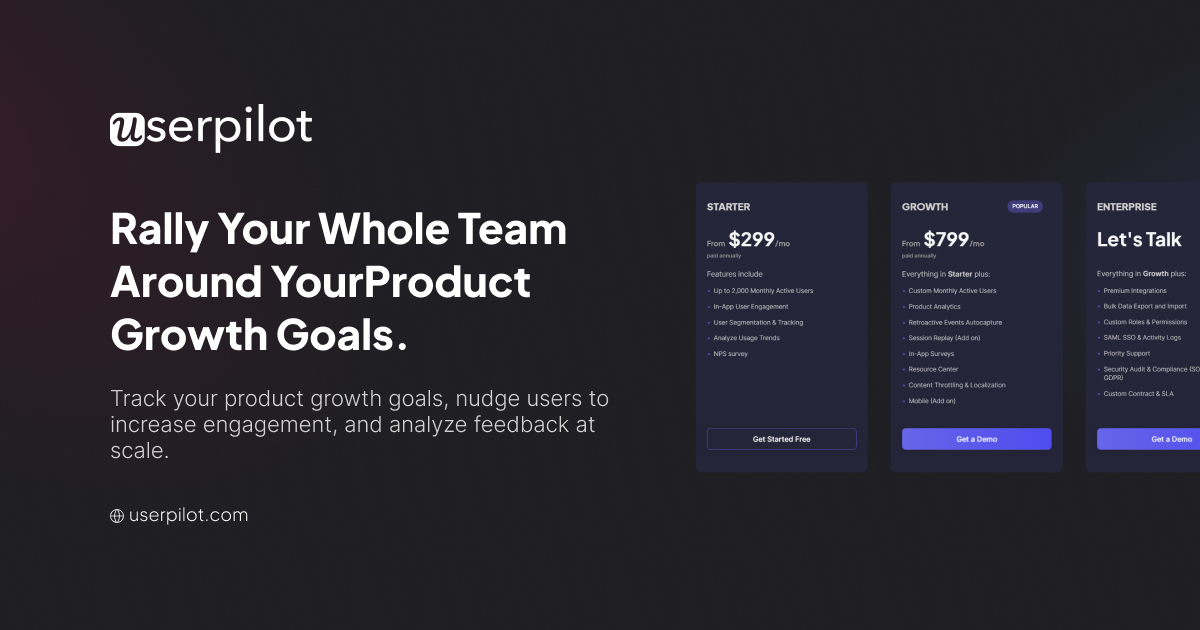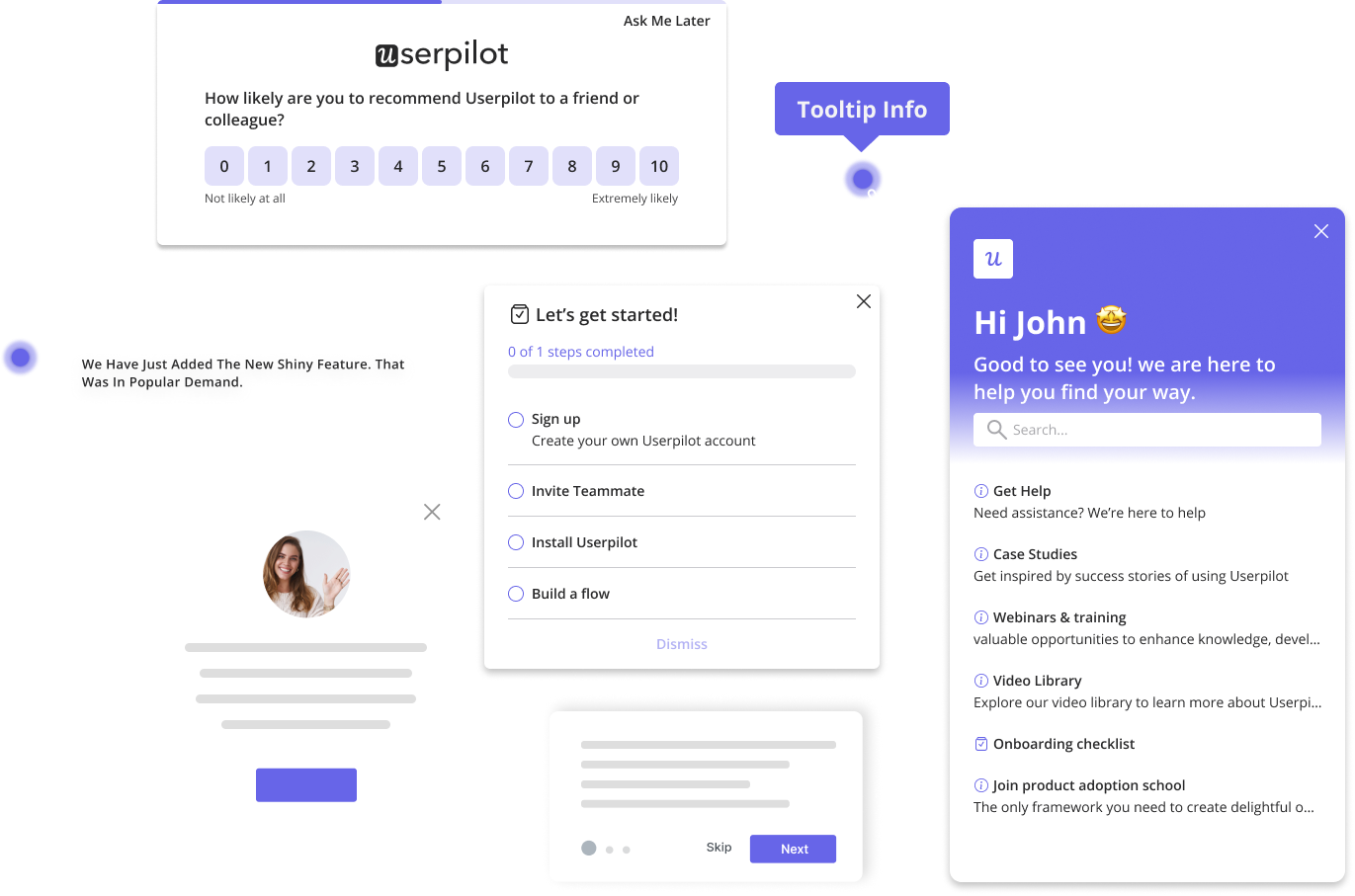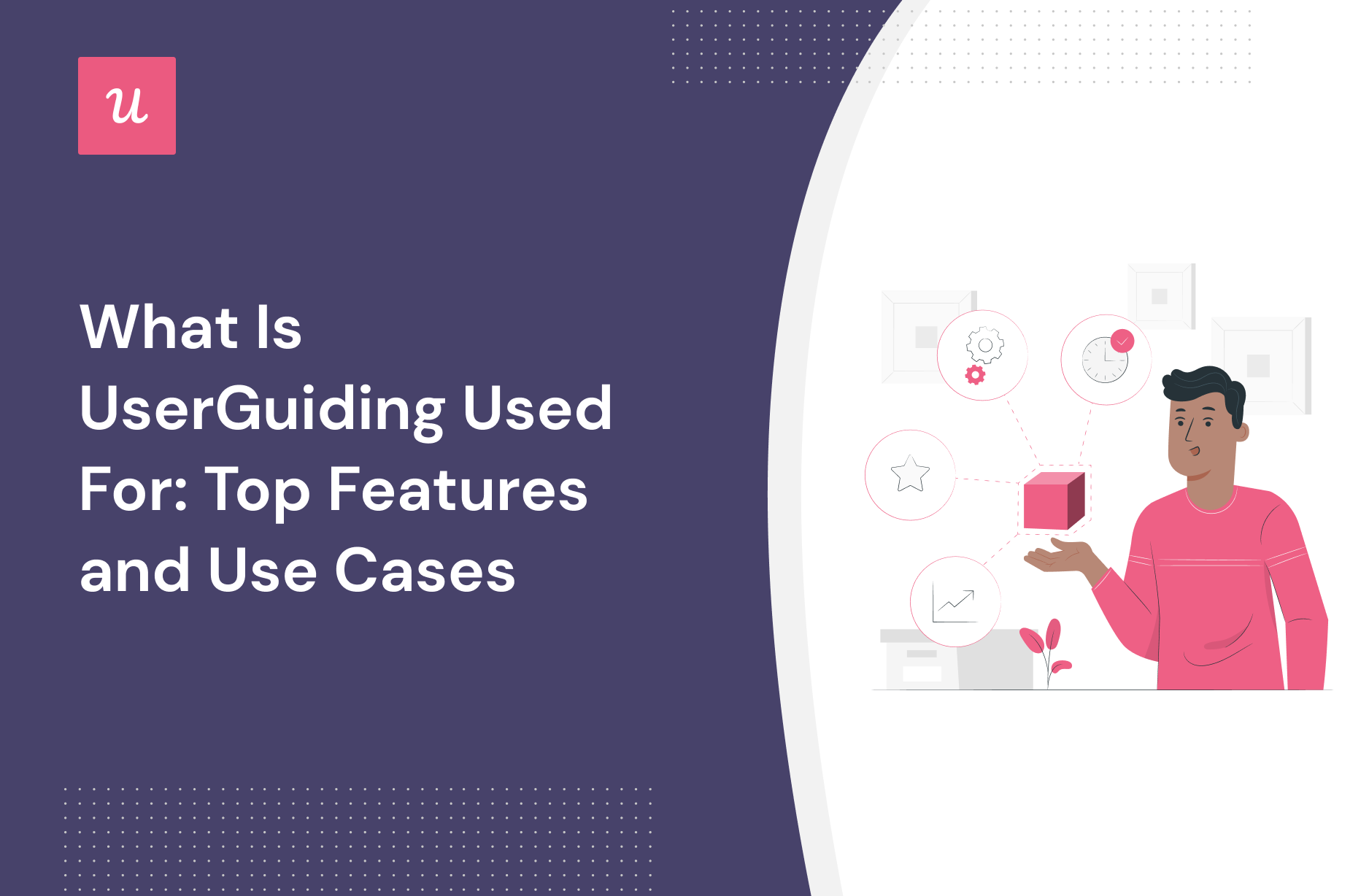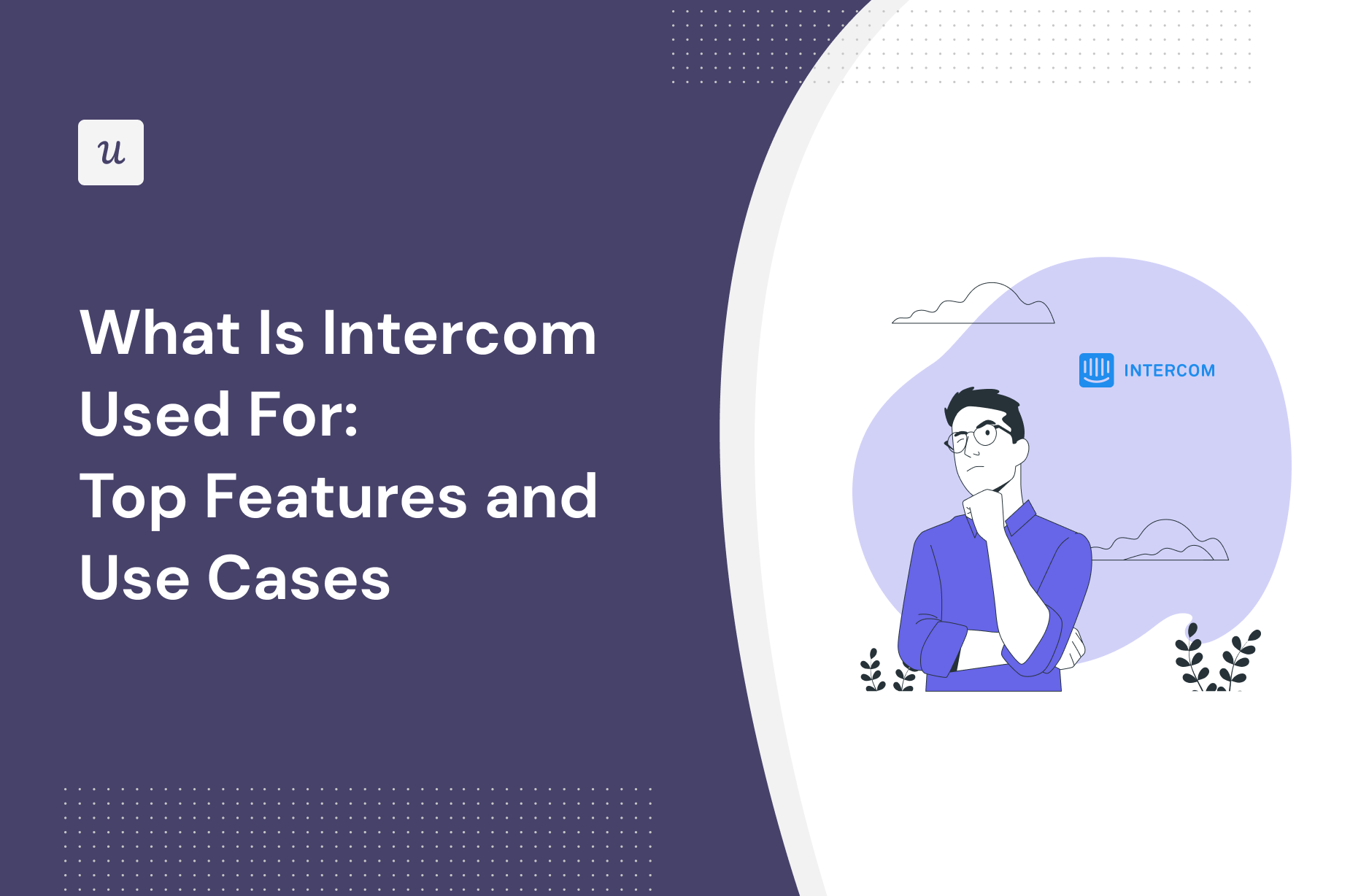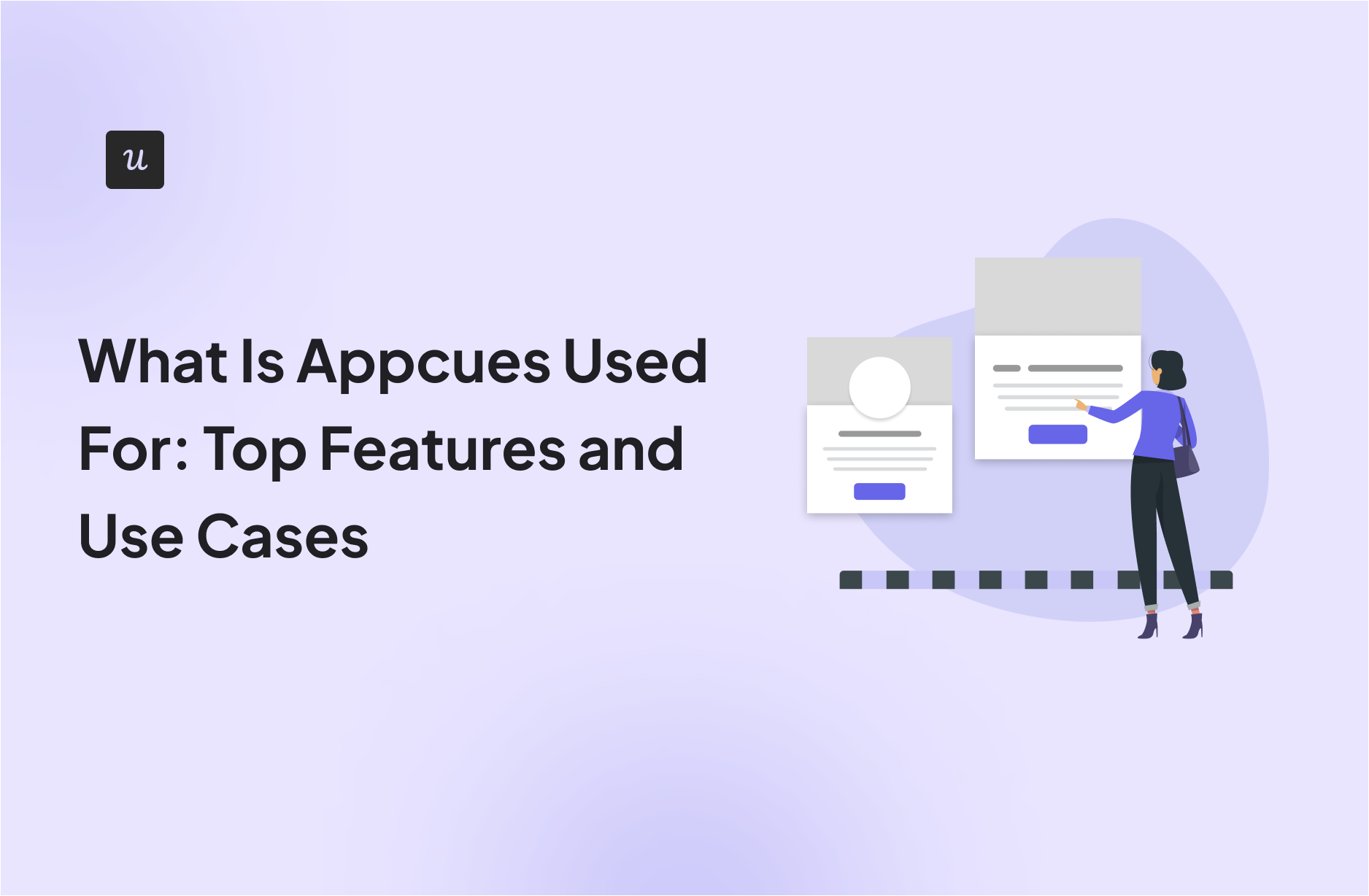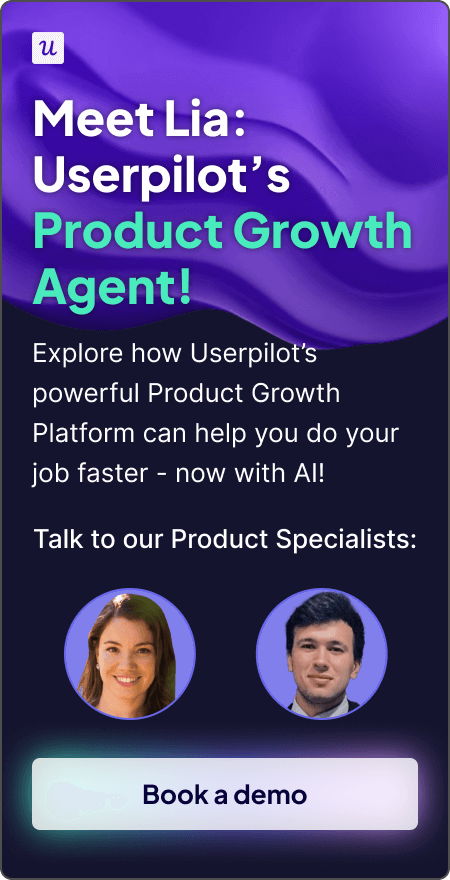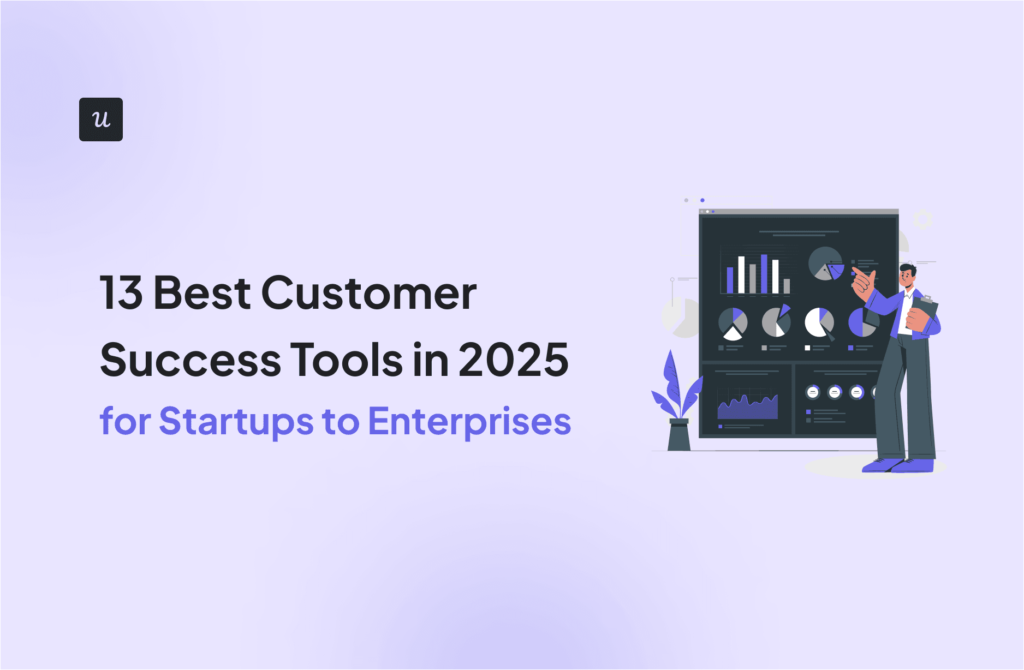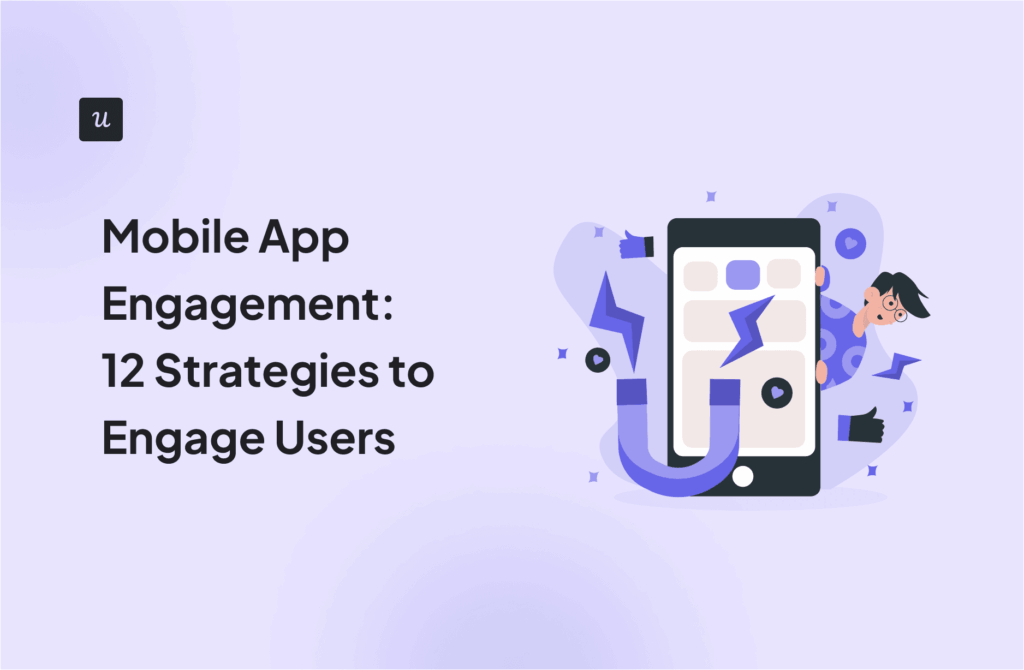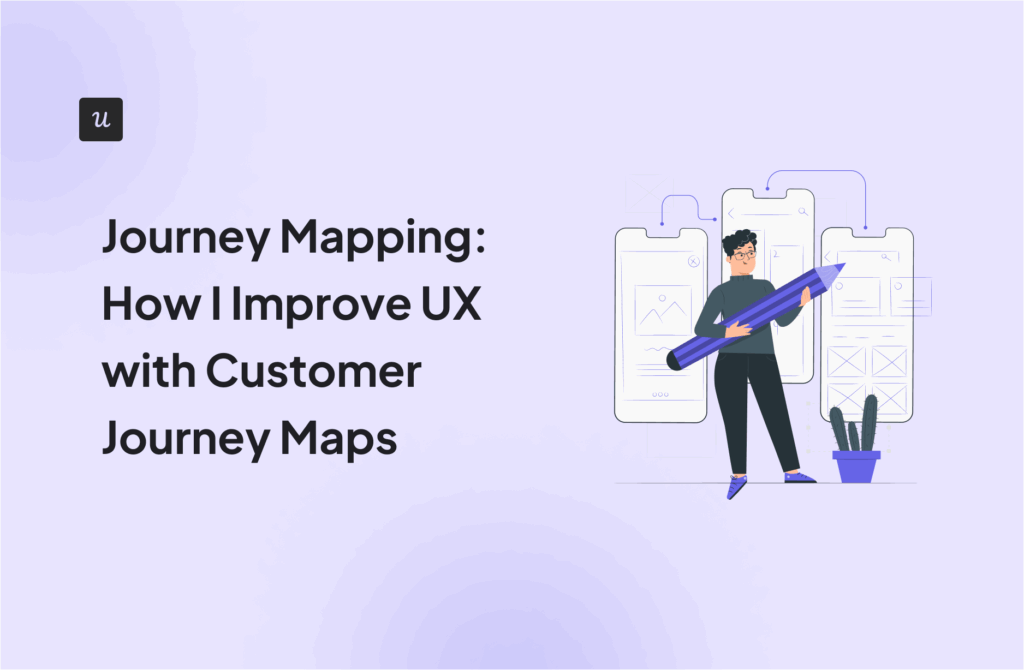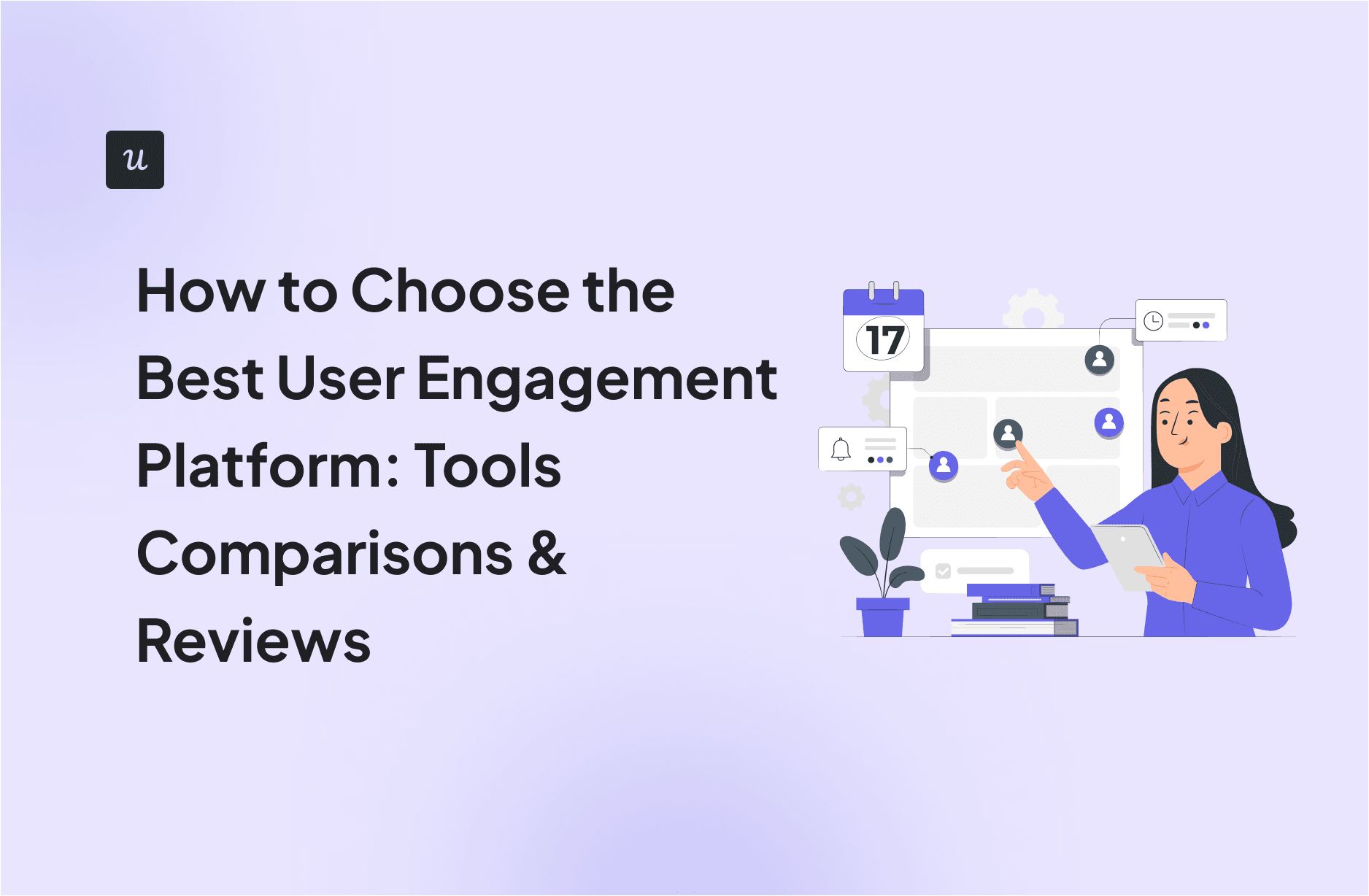
How to Choose the Best User Engagement Platform: Tools Comparisons & Reviews
A user engagement platform (UEP) is software that directly enhances user interactions within your product. It functions as a central hub that enables you to manage, track, and analyze how users experience your application.
Businesses use it to make every interaction relevant, timely, and valuable, driving measurable results such as 4x response rates, a 15% increase in feature adoption, and improved retention.
However, with so many customer engagement platforms on the market, selecting the best fit for your unique goals can feel overwhelming.
To cut through the noise, this guide shares my practical 4-step framework for choosing the best user engagement platform. I’ll cover the key features to prioritize, common pitfalls, and a comprehensive list of our top picks.
Try Userpilot Now
See Why 1,000+ Teams Choose Userpilot
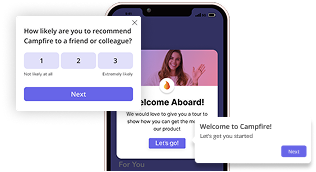
Top customer engagement tools for your needs
Here’s my breakdown of the top engagement tools and what they do best:
- Userpilot: Best for product teams needing no-code in-app guidance, user onboarding, omnichannel customer engagement, and product analytics in one platform.
- UserGuiding: Best for small teams wanting affordable, straightforward user onboarding without complex features.
- Pendo: Best for enterprises requiring comprehensive product analytics with basic engagement features.
- Intercom: Best for companies prioritizing live chat, customer support, and product engagement.
- Freshworks: Best for businesses seeking an all-in-one customer engagement solution across marketing, sales, and support.
- Appcues: Best for mid-market SaaS companies focused on user onboarding and feature adoption.
- MoEngage: Best for mobile-first companies needing advanced push notifications and cross-channel marketing campaigns.
- Braze: Best for large enterprises with dedicated engineering resources who need sophisticated cross-channel orchestration.
Userpilot
Best for: Product managers, customer success teams, and product marketers at SaaS companies (from startups to enterprises) who want to improve user activation, feature adoption, and customer retention without needing help from engineers.
Userpilot is for product teams who want to improve user engagement without writing code. Our platform combines in-app messaging, product analytics, and feedback collection into one unified solution.
Top features
- No-code builder: You can create tooltips, modals, slideouts, checklists, and banners without writing a single line of code.
- Self-service resource center: Build a knowledge base directly in your product so users can find answers without leaving your app or contacting support.
- A/B testing: Test different onboarding flows, messaging variations, and UX patterns to see what drives better user engagement.
- User segmentation: Target users based on their behavior in your product, not just demographic data. You can segment by feature usage, custom events, user properties, company data, or any combination. Want to show a feature announcement only to power users in enterprise accounts who haven’t tried your new integration? Done.
- Product analytics: Track what matters, such as feature adoption, conversion funnels, retention cohorts, and user paths. You can create custom dashboards that answer your questions, like “Which onboarding steps cause the most drop-off?” or “What do our most engaged users have in common?”
- Automatic event tracking with autocapture and session replay: Our autocapture feature automatically tracks user interactions across your product. You can also define custom events for specific business logic. Watch real user sessions to identify where people get stuck, confused, or frustrated. Instead of guessing why users drop off at a certain step, you can see exactly what happened with our session replay feature.
- Feedback collection: Trigger in-app surveys at specific points in the customer journey, right after a user completes a key action or hits a milestone. This contextual approach gets you higher response rates and more actionable customer feedback than generic email surveys sent at random intervals.
- Mobile engagement: If you’re engaging customers on mobile apps, we provide native support, including mobile-first patterns such as carousels, slideouts, push notifications, and in-app surveys. You get mobile analytics and targeting options through our SDK, so your messaging stays consistent whether users are on desktop or mobile.
- Email: Userpilot offers an email feature for product growth, allowing companies to send behavior-based messages to users outside of their product to re-engage them, announce features, or encourage upgrades. This feature helps companies improve retention and adoption by linking email campaigns to user behavior.
What customers say about Userpilot
Modern Expo used a contextual, behavior-driven approach, which helped them transform onboarding and engagement outcomes:

Beable Education faced a common challenge: Understanding which features drove student engagement and how to improve their onboarding experience. They transformed their customer engagement approach by leveraging Userpilot’s analytics and feedback features.

Beable tracked the entire customer journey and gathered real-time insights. The results speak for themselves: they drove student participation by 76.59% through targeted in-app surveys and consolidated three separate tools into Userpilot’s all-in-one solution.
What could be better
Userpilot is built primarily for user engagement, so it’s unsuitable for employee onboarding or engagement.
Final Verdict
Userpilot delivers exceptional value for product-led SaaS teams who need a complete user engagement solution without the complexity or cost of enterprise platforms.
| Choose Userpilot if you | Consider alternatives if you: |
|---|---|
| Need to build and launch onboarding flows without engineering support (our no-code builder is genuinely intuitive. | Are focused solely on employee onboarding rather than customer engagement. |
| Want product analytics, in-app engagement, and feedback collection in one platform instead of juggling multiple tools. | Primarily need live chat and support ticketing (Intercom might be better). |
| Need to move fast: you can create and deploy experiences in minutes, not weeks. | |
| Are a startup scaling to enterprise (our plans grow with you from $299/month to custom enterprise solutions). |
What sets Userpilot apart: The platform’s strength is in its unified approach: you get powerful analytics to understand user behavior, no-code tools to act on those insights, and feedback mechanisms to validate your decisions.
Companies like Beable Education consolidated three tools into Userpilot, simplifying their stack while improving results. Unlike competitors that excel in one area, Userpilot balances depth and usability across engagement, analytics, and feedback. You’re not sacrificing power for simplicity or vice versa.
G2 Rating: 4.6/5
Pricing: Starts at $299/month (billed for up to 2,000 monthly active users). Our pricing plans scale based on MAU, with additional features (such as Resource Center, email engagement, and data warehouse sync) available in higher tiers.
UserGuiding
Best for: Small teams wanting simple user onboarding without enterprise complexity.
UserGuiding is a straightforward onboarding tool that helps small teams create product tours and guides. The platform works well for basic onboarding flows such as simple step-by-step walkthroughs and checklists.
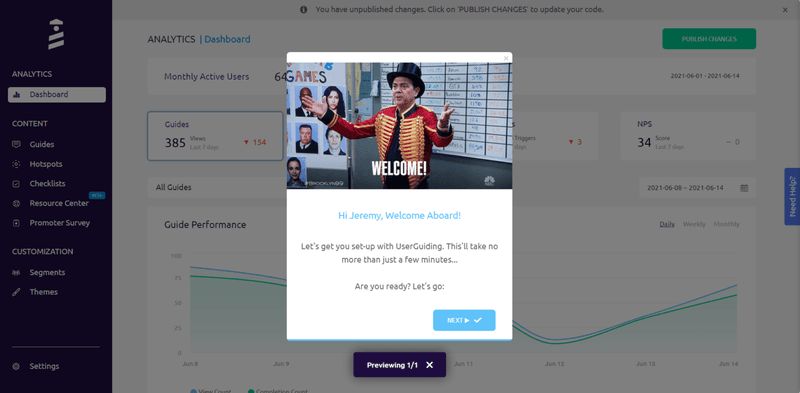
Top features
- Interactive product tours: Create multi-step walkthroughs using tooltips and modals to guide new users through key features.
- Onboarding checklists: Build simple task lists to help users complete essential setup steps.
- Hotspots: Add indicators to draw users’ attention to new features or important elements.
- Resource center: Provide a basic in-app help widget that lets users access guides and announcements.
- User segmentation: Target tours based on basic criteria such as user attributes or page URLs (though it’s much more limited than on enterprise platforms).
- NPS surveys: Collect NPS feedback to gauge customer satisfaction.
- Analytics dashboard: View completion rates and engagement metrics for your guides.
What customers say about UserGuiding
Users frequently note limitations. Several reviews mention the platform struggles with more complex use cases. Like this user said:
“Although the tool is very useful, it can sometimes feel limited in customization compared to more advanced platforms. The design options for tooltips and walkthroughs could be more flexible to match brand guidelines.”
What could be better
UserGuiding’s simplicity becomes a constraint as you scale. Its segmentation capabilities are surface-level. You can’t target based on behavioral triggers, custom events, or sophisticated user properties. This means you’ll struggle to deliver truly personalized customer experiences.
Final Verdict
UserGuiding is best for early-stage startups or small SaaS companies (under 50 employees) with straightforward onboarding needs and limited budgets. If you need basic product tours and don’t require deep analytics or advanced targeting, UserGuiding gets the job done.
G2 Rating: 4.7/5
Pricing: There’s a free plan. Paid plans start at $174/month (billed annually) for features like reporting and segmentation. Higher tiers add more monthly active users and capabilities such as A/B testing and personalized support.
Pendo
Best for: Enterprises prioritizing product analytics over engagement features.
Pendo shines in deep analytics like tracking feature usage, building custom reports, and providing product usage insights across large user bases.
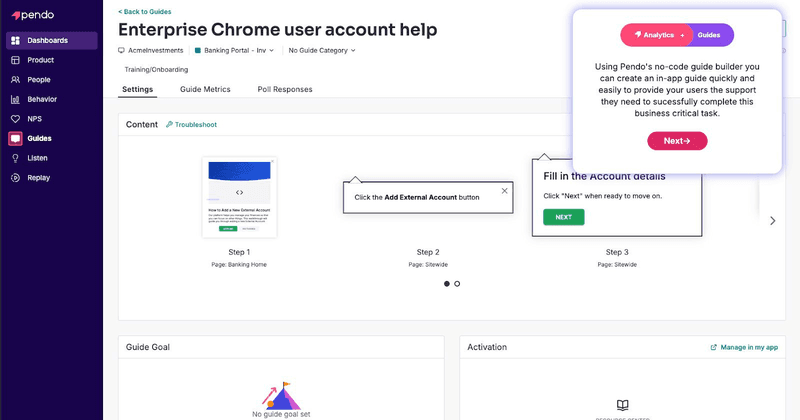
Top features
- Product analytics: Track feature adoption, user paths, and product usage patterns with comprehensive dashboards and custom reports.
- Retroactive data analysis: Access historical data to understand past user behavior without setting up tracking in advance.
- In-app guides: Create walkthroughs and tooltips to guide users, though the builder is less intuitive than specialized onboarding tools.
- Resource center: Provide a help widget with guides, announcements, and documentation.
- NPS and polls: Collect customer feedback through in-app surveys
- Product roadmap portal: Share your roadmap with users and gather feature requests.
- Session replay: Watch user sessions to identify friction points (available in higher-tier plans).
- Segmentation: Create user segments based on behavior, properties, and usage patterns for targeting.
What customers say about Pendo
Pendo’s engagement features receive mixed feedback. Multiple reviews highlight usability concerns:
“Sometimes the dashboard take a bit of time to load when are analyzing large sets of data. The initial setup required some guidance, and I felt the learning curve was slightly steep for advanced features.”
Pricing is another common complaint:
“Their pricing/licensing model is inflexible and old school. E.g. as of this writing when you go to their pricing page you get a “request pricing” button instead actual information.”
What could be better
Pendo’s engagement tools aren’t as polished or powerful as dedicated user engagement platforms. The guide builder requires more technical knowledge than truly no-code solutions, so your marketing or customer success teams will likely need help from product or engineering.
The pricing model can shock you as you grow. Pendo’s pricing is unclear, but according to Vendr, a SaaS negotiation platform, Pendo pricing ranges from $15,000 to $142,476 annually, with a median of $48,300.
Final Verdict
Pendo is best for mid-to-large enterprises (500+ employees) with substantial budgets who prioritize deep product analytics and can tolerate typical engagement tools. Works well if you already have a dedicated product analytics team and only need basic onboarding capabilities.
G2 Rating: 4.4/5
Pricing: Pendo is not public about its pricing plans, but customer reviews show it’s on the high side. Data from Vendr, based on 500+ real purchases, suggests a starting price of around $15,000 per year, with prices reaching over $140,000 annually for higher tiers.
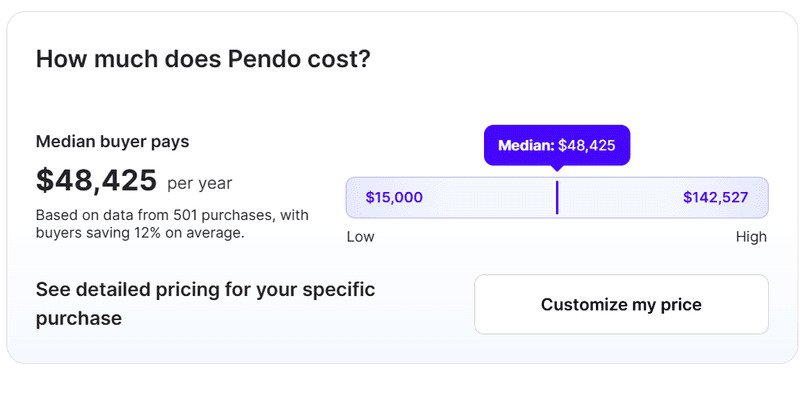
What’s your main goal with a user engagement platform?
The best tool for you is the one that solves your specific use case. What’s your top priority right now?
How are you currently guiding new users?
Effective onboarding is key to activation. What does your current process look like?
How do you measure the success of new feature launches?
Announcing is one thing, but measuring the impact on adoption is another.
What’s your biggest challenge with user feedback?
Qualitative data explains the “why” behind user actions. Where do you struggle most?
Find the right user engagement platform for your goals.
Stop struggling with data silos, limited tools, or expensive custom development. See how Userpilot can help you achieve your specific product goals and drive growth.
Intercom
Best for: Companies prioritizing live chat and customer support alongside product engagement.
Intercom is a communications-centric platform that enables you to serve customers across multiple channels. These channels include live chat, email, push notifications, and in-app messages.
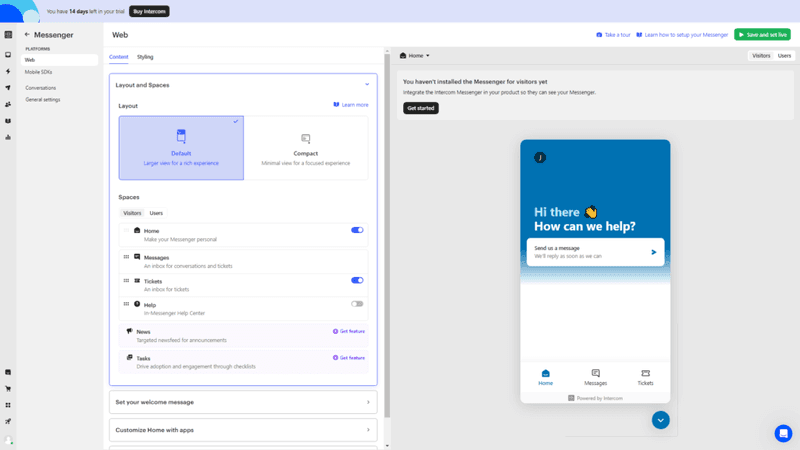
Top features
- Live chat and messaging: Provide real-time support through a chat widget that works across your website and mobile apps.
- AI-powered chatbot (Fin): Automate customer support responses using AI that learns from your knowledge bases and past conversations.
- Shared inbox: Give your customer service teams a central place to manage customer interactions across multiple communication channels.
- Outbound messaging: Send targeted emails, push notifications, and in-app messages based on user behavior.
- Product tours: Create basic onboarding flows and tooltips (though far less sophisticated than dedicated onboarding tools).
- Help center: Build a self-service knowledge base for customers to find answers independently.
- Custom bots: Design conversation flows to qualify leads, route support tickets, or guide users through everyday tasks.
- Reporting and analytics: Track conversation volume, response times, and customer satisfaction metrics.
What customers say about Intercom
G2 reviewers frequently complain about Intercom’s pricing and limited integrations. One review states:
“The idea of paying per “resolution” sounds good in theory—it feels like you’re only paying for value. However, the costs can become high and unpredictable, especially when your support volume is high.Could have more integrations, and cost is still a barrier for small business (high ticket).”
What could be better
Intercom’s analytics focus heavily on support metrics such as conversation volume, response times, and CSAT scores. However, it provides minimal insight into actual product usage and user behavior. You won’t get funnel analysis, retention cohorts, feature adoption tracking, or the detailed customer data.
Final verdict
Intercom is best for companies where customer support is the primary focus and you need a powerful live chat and ticketing system. I’d recommend it if you have a dedicated support team handling high message volumes and can afford premium pricing.
G2 Rating: 4.5/5
Pricing: A free 14-day trial is available. Intercom’s paid plans start at $0.99 per Fin resolution and $29 per seat/mo, billed annually.
Freshworks
Best for: Businesses seeking an all-in-one customer engagement solution.
Freshworks is a “jack of all trades” platform for small to mid-sized businesses that need basic functionality across customer service, sales, and marketing.
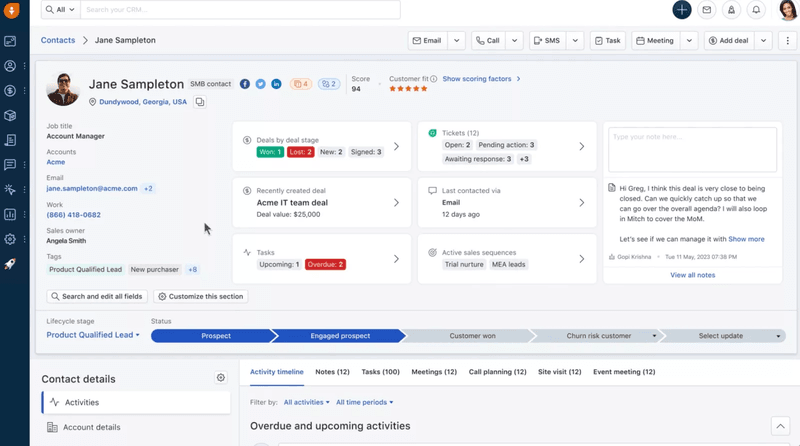
Top features
- Omnichannel support (Freshdesk): Manage customer interactions across email, phone, live chat, social media platforms, and messaging apps from one inbox.
- CRM and sales automation (Freshsales): Track customer journeys from lead to close with pipeline management, email tracking, and AI-powered deal insights.
- Marketing automation (Freshmarketer): Create email campaigns, segment audiences, and track marketing efforts across multiple channels.
- Live chat and chatbots (Freshchat): Provide real-time support and automate conversations with AI-powered bots.
- Knowledge bases: Build self-service portals that let customers find answers without contacting support teams.
- Ticketing system: Route, prioritize, and efficiently manage customer support requests.
- Reporting and analytics: Track support metrics, sales performance, and campaign effectiveness across the suite.
- Mobile apps: Manage customer interactions on iOS and Android devices.
What customers say about Freshworks
Customers appreciate the user-friendliness. One customer noted:
“Freshdesk provides a very intuitive and user-friendly interface, making it easy for both agents and customers to navigate.”
However, its analytics are limited. One review highlights:
“It has limitations in Analytics. When exporting data, it only allows you to export to PDF, not to Excel. Also, every time I select any parameter in my custom dashboard, it always asks to save the settings.”
What could be better
Freshworks lacks true customer engagement capabilities. There’s no in-app guidance, product tours, or feature adoption tracking. You can send emails and chat messages, but can’t build interactive walkthroughs, tooltips, or checklists within your product.
Final Verdict
Freshworks is best for small businesses that need basic support, sales, and marketing tools, and value vendor consolidation over specialized capabilities. The platform works well if your primary focus is customer service and you don’t need product-specific engagement features.
G2 Rating: 4.5/5
Pricing: Freshworks starts at $15/user/month for basic support features, with different pricing for sales and marketing products. Can bundle products for volume discounts.
Appcues
Best for: Mid-market SaaS companies focused on user onboarding and feature adoption.
Appcues is a dedicated user onboarding platform that helps you create product tours, announcements, and checklists without coding. It’s been around since 2013, making it one of the older players in the space.
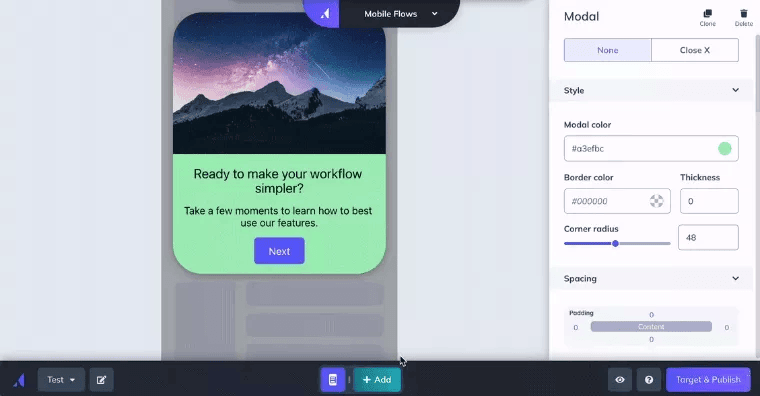
Top features
- Onboarding flows: Create multi-step product tours using modals, tooltips, and slideouts to guide new users.
- Checklists: Build task lists that help users complete necessary setup steps and track progress.
- Announcements and modals: Share feature updates, promotions, or important messages through in-app pop-ups.
- Hotspots: Add attention-grabbing indicators to highlight new features or important elements.
- NPS surveys: Measure customer satisfaction with in-app NPS surveys.
- User segmentation: Target experiences based on user properties, though options are more limited than enterprise platforms.
- A/B testing: Test different onboarding variations to see which performs better.
- Mobile SDK: Create onboarding experiences for iOS and Android mobile apps.
What customers say about Appcues
Limitations surface frequently in reviews. One user noted:
“The only thing I don’t like so far is that I’m on an account with certain limits (like my number of segments I can target) and I want to upgrade sooner than I thought I’d have to.”
What could be better
Analytics in Appcues remain relatively surface-level. While you can track completion of individual flows and set one primary goal per flow, you won’t get native funnel analysis, retention cohorts, path analysis, or rich customer-behavior data out of the box.
Final Verdict
Appcues is best for mid-market SaaS companies (50-200 employees) with straightforward onboarding needs. It works if you only need basic product tours and don’t require deep analytics or advanced targeting.
G2 Rating: 4.6/5
Pricing: Starts at $300/month for one app, including flows and checklists. Higher plans include features such as the Resource Center, NPS, and unlimited user licenses.
MoEngage
Best for: Mobile-first companies needing advanced push notifications and cross-channel marketing campaigns.
MoEngage excels at push notifications, in-app messaging for mobile, and orchestrating marketing campaigns across multiple channels. If you’re running a mobile app with millions of users and need sophisticated marketing automation, MoEngage delivers.
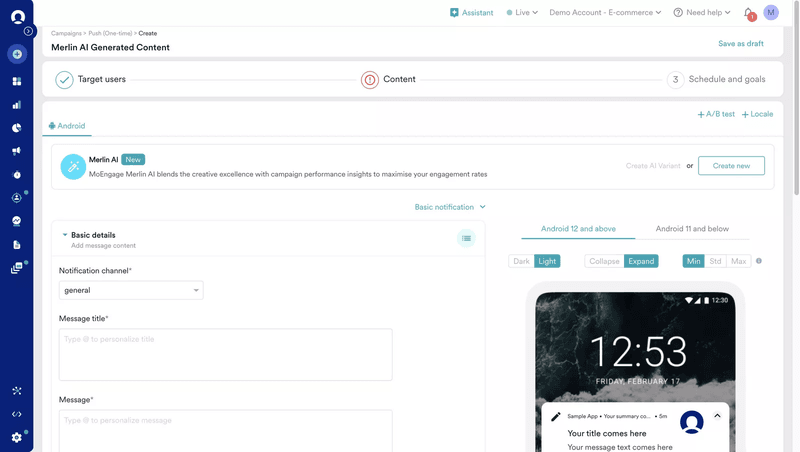
Top features
- Advanced push notifications: Send targeted, personalized push notifications with rich media, deep linking, and optimal timing based on user behavior.
- In-app messaging: Display banners, modals, and cards within mobile apps to engage users in context.
- Cross-channel campaigns: Orchestrate marketing campaigns across push, email, SMS, WhatsApp, and in-app channels from one platform.
- AI-powered optimization: Use Sherpa AI to determine the best time, channel, and message for each user.
- User segmentation: Create audience segments based on user behavior, demographics, and engagement patterns.
- Flow campaigns: Build automated customer journeys that trigger based on specific actions or time delays.
- A/B testing: Test different message variations, timing, and channels to optimize engagement strategies.
- Analytics and reporting: Track campaign performance, user behavior, and engagement metrics across channels.
What customers say about MoEngage
G2 reviewers mention implementation complexity as a recurring complaint:
“While the platform is feature-rich, it can feel a bit overwhelming at first, especially for new users or teams without a dedicated CRM/MarTech resource.”
What could be better
MoEngage is primarily a marketing-campaign platform, not a customer-engagement toolbox. You won’t find built-in product tours, interactive walkthroughs, or tooltips for onboarding users inside your app or web product. Its in-app messaging capabilities are mostly limited to announcements or promotional pop-ups.
Final Verdict
MoEngage excels at mobile marketing automation for companies with high user volumes. It’s ideal if you need sophisticated push campaigns, AI-powered send-time optimization (Sherpa AI), and coordinated campaigns across push, email, SMS, WhatsApp, and in-app channels. Best suited for teams with dedicated marketing or CRM resources (the platform is powerful but complex).
Skip MoEngage if you need product-led features like interactive tours, tooltips, or onboarding walkthroughs. It’s a marketing tool, not a product engagement platform. Also, it is not ideal for small teams without MarTech specialists, web-focused apps, or those needing deep product analytics.
G2 Rating: 4.6/5
Pricing: For details about MoEngage’s pricing, contact their sales team.
Braze
Best for: Large enterprises with dedicated engineering resources that need sophisticated cross-channel orchestration.
Braze is an enterprise-grade user engagement platform built for scale. The platform is designed for large consumer brands, media companies, and e-commerce platforms running sophisticated marketing campaigns.
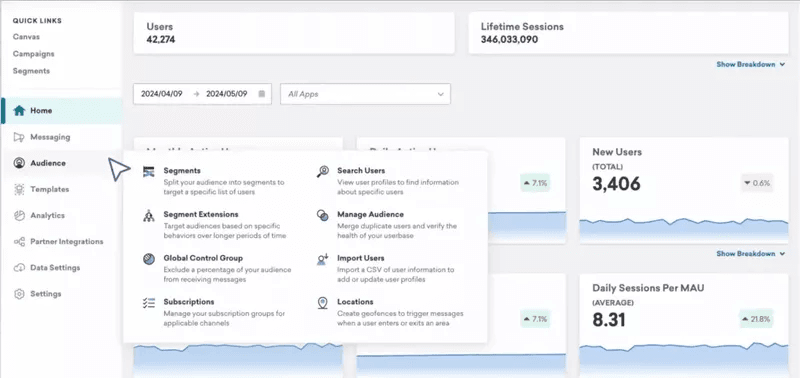
Top features
- Cross-channel messaging: Orchestrate campaigns across push notifications, email, SMS, WhatsApp, in-app messages, content cards, and webhooks.
- Canvas journey builder: Create complex, multi-step customer journeys with branching logic, delays, and audience splits.
- Advanced segmentation: Build sophisticated audience segments using behavioral data, custom events, and predictive attributes.
- Real-time personalization: Deliver personalized experiences with Liquid templating and dynamic content powered by user data.
- AI and predictive analytics: Use machine learning for churn prediction, send time optimization, and intelligent channel selection.
- A/B and multivariate testing: Run experiments across messages, channels, and journey variations to optimize engagement strategies.
- Data ingestion and activation: Connect customer data platforms and warehouses to create a unified view of customer interactions.
- Enterprise security: SOC 2, HIPAA, and GDPR compliance with advanced security features for regulated industries.
What customers say about Braze
Reviewers highlight how it supports email, push notifications, SMS, in-app messaging, and other channels under one roof:
“Braze has built a platform that integrates all channels for a full CRM experience – SMS, email, app push, etc.”
However, complexity is a universal complaint:
“There’s definitely a learning curve with Braze, and you’ll need to go through a ton of resources and documentation”
What could be better
While Braze supports in-app messaging, it doesn’t offer the full user engagement features many product teams expect. You’ll find cards and basic messages, but no built-in product tours, interactive walkthroughs, tooltips, or contextual guidance flows for feature adoption and onboarding.
Final verdict
Braze is best for large enterprises (1,000+ employees) with millions of users, particularly in consumer apps, e-commerce, media, or financial services. You can try it, but it makes more sense if you have dedicated engineering resources and genuinely need enterprise-scale cross-channel orchestration.
G2 Rating: 4.5/5
Pricing: You’d have to contact Braze’s sales team for pricing.
Why is it important to choose the right user engagement software for your needs?
Choosing the wrong customer engagement platform inevitably leads to costly problems. I’ve observed teams accumulating too many disconnected user engagement tools or relying on limited stacks that hinder product growth.
Both approaches consistently produce issues that damage customer relationships and drain resources. Such issues include:
- Fragmented customer data: Separate tools scatter critical user data, preventing unified views across marketing, sales, and customer success teams. When your marketing team can’t see customer interactions from support, or your sales teams lack visibility into user behavior, you end up sending inconsistent messages. This creates a disjointed customer experience strategy that erodes trust by confusing users.
- Wasted resources: In-house solutions are often rigid, expensive to maintain, and drain engineering time that could be spent building your product. Similarly, investing in customer engagement software that your team cannot or will not use effectively is simply throwing money away. Avoid paying for robust user engagement platforms with advanced segmentation and automation features that you won’t use, especially when the interface is too complex.
- Poor customer experience that drives churn: When you can’t provide timely, personalized experiences through multiple channels, you frustrate users. This user friction quickly leads to customer churn and missed upsell opportunities. Users expect seamless communication whether they’re in your mobile app, on your website, or reaching out via live chat. Delivering that consistent experience across customer journeys is nearly impossible without the right engagement platform.
You can avoid these traps by strategically choosing a UEP. The proper UEP streamlines communication, centralizes data, and empowers your team to deliver personalized customer experiences at scale. It is a product growth platform that frees you to focus on strategic initiatives rather than technical headaches.
How to choose the right customer engagement platform?
To proactively avoid those pitfalls, I developed a practical 4-step framework for evaluating user engagement platforms.
This framework guarantees you select a UEP that has impressive features and aligns with your business objectives and team workflows:
- Align with product goals: Clearly define the outcomes you want to achieve.
- Define specific use cases: Translate those goals into concrete scenarios and user segments.
- Map platform strengths: Identify which features genuinely meet your particular needs.
- Evaluate based on the main criteria: Assess usability, flexibility, pricing, and support.
Step 1: Align your choice with core product goals
Before evaluating features, define your core objectives: What are we truly trying to achieve? What is the biggest obstacle our users face, and how will an engagement platform directly overcome it?
Focusing on outcomes helps you avoid distractions in the form of flashy, unnecessary features. For UEP, typical goals include:
- Improved customer activation rates by guiding new users to their “Aha!” moment faster through in-app messaging and interactive walkthroughs.
- Better customer retention by proactively addressing pain points and nurturing long-term relationships across multiple channels.
- Increased feature adoption for new or underutilized parts of the product to maximize value and reduce customer churn.
- Gathered actionable customer feedback to inform product development and prioritize improvements based on real user behavior.
Defining these goals upfront creates a clear roadmap for evaluating potential solutions. This way, you ensure every feature directly contributes to these core objectives and your overall customer engagement strategy.
Step 2: Detail specific user engagement use cases
With your goals defined, specify concrete use cases. How, precisely, will the user engagement platform achieve those outcomes? This question demands an intimate understanding of your user segments and their entire customer journeys.
For example, engaging a first-time user differs significantly from engaging a power user. Similarly, a technical user requires different guidance from a non-technical one.
Consider concrete scenarios: “We need to onboard users who signed up via our mobile app, guide them through three key setup steps, and collect feedback on that flow in their native language.” Or, “We need to announce a new integration to users actively using feature X, but only if they haven’t tried integration Y through push notifications.”
In my work, I always prioritize use cases as “must-haves” or “nice-to-haves” to ensure we invest in features that deliver immediate impact. This detail rigorously tests a platform’s ability to handle your real-world needs to drive engagement across customer touchpoints.
Step 3: Match platform capabilities to defined use cases
With your goals and precise use cases defined, evaluate each platform’s offerings. Many customer engagement tools appear similar, but critical differences emerge in the details. I focus on these core UEP capability areas:
- In-app guidance for onboarding & product adoption: Including interactive walkthroughs, tooltips, checklists, and product tours. These features help you guide users to product value quickly without relying on your customer service teams all the time. A no-code builder is a huge plus, so your marketing team can create personalized experiences without engineering support. Self-service options such as knowledge bases and resource centers are also needed. They empower users to find answers independently, reducing support tickets while improving customer satisfaction.
- Analytics to understand user behavior: Look for features that provide real-time insights to understand customer interactions. Can you see which flows drive conversion? Where do users drop off? Advanced segmentation capabilities let you slice data by user properties, behavior, and engagement level. Overall, a complete view of customer first-party data is vital for analytics.
- Feedback & UX research for product insights: Collecting feedback directly within your product is crucial for continuous improvement. Look for platforms that support in-app surveys, NPS tracking, and user sentiment analysis. The best customer engagement platforms let you trigger surveys based on specific user actions or milestones. This feature ensures you gather contextual feedback when it matters most.
Step 4: Holistically evaluate platforms against key criteria
After mapping features to your use cases, a holistic evaluation is essential. I prioritize these criteria, moving beyond mere features to practical considerations:
- Prioritize easy setup & daily use: A UEP must offer rapid installation and intuitive daily use, as minimal setup effort is crucial. A user-friendly interface with a no-code builder empowers your non-technical teams to quickly create personalized interactions. Userpilot’s intuitive interface exemplifies this.
- Assess platform flexibility & adaptability: Your business will evolve, so your UEP must adapt. Seek a tool that provides a wide range of UI templates and supports building non-linear journeys with progressive groups and flow logic. This guarantees your investment today serves your evolving needs or engagement strategies tomorrow.
- Demand deep analytics: Beyond basic reports, I demand actionable analytics that directly connect to our customer engagement efforts. Can I see how a specific flow impacts conversion or retention? A UEP like Userpilot provides flow performance analytics, delivering this vital feedback.
- Insist on transparent pricing models: Hidden costs will derail any budget. A reliable vendor, like Userpilot, clearly outlines its pricing model, typically based on Monthly Active Users (MAU). This transparency ensures there are no surprises or unexpected spikes as you scale.
- Verify scalability & robust support: As your product grows, your customer engagement platform must scale with it. Demand features like separate staging and production environments for testing, and robust enterprise capabilities such as SCIM for user provisioning and SSO for secure access. Strong customer success support is non-negotiable for smooth implementation and ongoing optimization.
- Ensure comprehensive integration ecosystem: Your UEP cannot operate in a silo. Seamless integrations with your existing tech stack, including HubSpot, Salesforce, Amplitude, Mixpanel, Heap, Segment, Google Analytics, and Intercom, are mandatory. Features for raw data export to your data warehouse are also critical for custom analyses. Such features help you get a complete omnichannel customer engagement view.
- Mandate strong security & compliance: This is non-negotiable for any SaaS. The platform must be SOC 2 Type II certified and support critical security configurations, such as Content Security Policy (CSP) and Subresource Integrity (SRI). Vague answers here are a major red flag.
Choose the right user engagement platform and start building better customer experiences
The UEP you choose today shapes every customer interaction tomorrow. So, make it count.
The platforms we’ve covered offer different strengths. Some excel at AI-powered automation and marketing campaigns. Others shine in detailed analytics and tracking customer journeys. Your job is to match those capabilities to your specific needs using the framework I’ve shared.
Ready to see how Userpilot can help you deliver exceptional customer engagement at scale? Book a demo and discover how our no-code builder, comprehensive analytics tools, and automation features make it easy to create personalized interactions that enable you to achieve your business results.

